Notes: Radcliffe Black Lane station was situated on the Lancashire & Yorkshire Railways (LYR) Liverpool, Bolton and Bury line. The line had been promoted by east Lancashire industrialists as the Liverpool & Bury Railway (L&BR). They wanted better access to the port of Liverpool so that they could bring in raw materials and export their goods more effectively. The L&B was authorised on 31 July 1845 and work began shortly after. The L&B became part of the LYR on 9 July 1847 before the first section of the line was opened. The section of line on which Radcliffe Black Lane was located (between Bolton and Bury Knowsley Street) was opened on 20 November 1848. On 1 May 1848 a line had opened between Bury and the LYR Manchester and Leeds railway at Castleton which provided a through route to Rochdale.
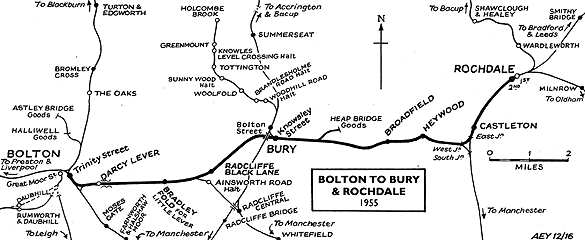 |
The station opened with the line on 20 November 1848 called simply Black Lane. It was located on the east side of Ainsworth Road (called Black Lane at the time of opening) which passed over the line on a brick arched bridge. The line was double track and the station was provided with two platforms. The main facilities were housed on the up (Bury direction) platform within a modest single-storey brick building with rectangular openings under a hipped slate roof.
Access was via a driveway on the north side of the line and a sloping path on the south side.
At the time of opening there were no facilities on the down platform (Bolton direction) but by the 1880s a timber structure of similar appearance to that on the up platform, but somewhat smaller, had been added.
At the time of opening the platforms were probably low and relatively short but at some point after 1882 they were extended. They were of equal length but staggered, the down platform extending about 30yd on the west side of Ainsworth Road. Only the western end ramp of the up platform extended to the west of the bridge and it extended further east than the down platform. The reason for this arrangement was because of sidings which opened in 1882 to serve the Black Lane Mills cotton spinning factory. The sidings were located on the south side of the line and they restricted the space available for a down platform.
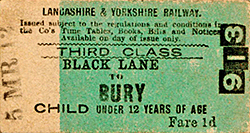 Black Lane was not provided with public goods sidings as it was only 2 miles from Bury Knowsley Street which had extensive facilities. Black Lane was not provided with public goods sidings as it was only 2 miles from Bury Knowsley Street which had extensive facilities.
The March 1850 timetable showed three up and four down trains on Monday-to-Saturday. On Sunday there were three trains in each direction. They ran between Liverpool and Rochdale.
In 1875 a signal box was opened at Black Lane station. It was located on the west side of the Ainsworth Road bridge on the down side of the line.
The December 1895 timetable showed 12 up and 15 down trains on Monday-to-Friday. On Saturday there was an extra service in each direction. Even on Sunday there was a good level of service with eight up and ten down trains.
On 5 May 1905 a tramway opened along Ainsworth Road operated by Bury Corporation on a route that linked the Three Arrows pub to Whitefield via Radcliffe. It is unlikely that the trams caused any loss of passengers at Black Lane station as the destinations served were different (Click here to read more about the Ainsworth Road tramway).
In 1913 the station signal box was replaced. The new box was located at the western end of the up platform on the west side of the Ainsworth Road bridge. It was an LYR type of box but built up to a great height on a brick base. The wooden cabin was at an elevation higher than Ainsworth Road which allowed the signalmen to see a clear view of the line eastwards. The box had a 20-lever LYR rear-mounted frame. Because of its height it also had an internal staircase.
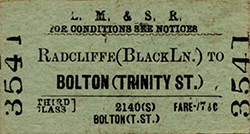 The LYR opened a halt on Ainsworth Road a short distance to the south of Black Lane station on 1 January 1918. It was on a line that had opened between Radcliffe South Junction and Bradley Fold Junction (the latter being ½ mile to the west of Black Lane station) on 1 December 1879. The halt was served by a rail-motor train that ran between Bolton and Radcliffe and it would have competed with the tramway for business. The LYR opened a halt on Ainsworth Road a short distance to the south of Black Lane station on 1 January 1918. It was on a line that had opened between Radcliffe South Junction and Bradley Fold Junction (the latter being ½ mile to the west of Black Lane station) on 1 December 1879. The halt was served by a rail-motor train that ran between Bolton and Radcliffe and it would have competed with the tramway for business.
On 1 January 1922 Black Lane became part of the London & North Western Railway (LNWR). The July 1922 timetable showed 15 up and 19 down trains on Monday-to-Friday. The Saturday service consisted of 15 up and 21 down trains. On Sunday there were six up and ten down services. Destinations served included Blackpool Central, Bolton Trinity Street, Liverpool Exchange and Rochdale.
A further change of ownership came on 1 January 1923 when the LNWR merged with other companies to become the London Midland & Scottish Railway (LMS).
In August 1927 there was a severe flood at Black Lane station. Heavy rain caused local streams to overflow and a culvert that passed under the line could not cope with the discharge. Water rose to platform level. A 4.15pm up train managed to pass through the flood but after it had done so the line through Black Lane had to be closed. Trains were diverted via Radcliffe West Junction, Radcliffe North Junction and the Bury Loop Line (click here to see photos of the flood).
The LMS renamed the station Radcliffe Black Lane on 1 July 1933.
Trams ceased to run along Ainsworth Road after 9 October 1938 (since 3 June 1929 they had run only during the peak with buses operating at other times).
During the Second World War the station gained extra traffic as the adjacent mill was taken over by the army as a barracks and prisoner of war camp.
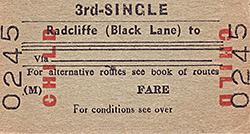 The LMS timetable for the summer of 1947 showed 15 trains in each direction on Monday-to-Friday. On Saturday there were 17 up and 19 down services. The station was open on Sundays being served by seven trains in each direction. On 1 January 1948 Radcliffe Black Lane became part of British Railways (BR) London Midland Region (LMR). The BR(LMR) timetable for summer 1949 showed a similar level of service to that of the LMS during its last year. The LMS timetable for the summer of 1947 showed 15 trains in each direction on Monday-to-Friday. On Saturday there were 17 up and 19 down services. The station was open on Sundays being served by seven trains in each direction. On 1 January 1948 Radcliffe Black Lane became part of British Railways (BR) London Midland Region (LMR). The BR(LMR) timetable for summer 1949 showed a similar level of service to that of the LMS during its last year.
BR(LMR) renewed the signage of the station in the late 1950s, installing vitreous enamel running-in boards and totem nameplates as well as miscellaneous direction and facilities signs. Gas lighting was, however, retained until the station closed.
On 1 November 1958 the station signal box was closed and soon demolished.
The September 1962 timetable showed 26 up and 25 down services on Monday-to-Friday. The Saturday service consisted of 29 up and 25 down trains (click here to see a table showing the times). On Sunday there were 13 up and 12 down services.
The Reshaping of British Railways (the ‘Beeching Report’) of March 1963 did not list the passenger services on the Bolton – Castleton line for withdrawal but they were in the ‘for modification’ list. On 30 October 1964 BR(LMR) proposed that passenger services between Wigan Wallgate, Bolton, Bury and Rochdale should be withdrawn, and this generated a great deal of local protest. From the start of the winter 1964 timetable Sunday services ceased to operate.
On 14 September 1966 Barbara Castle, the Minister of Transport, refused to sanction withdrawal of the passenger service between Wigan, Bolton, Bury and Rochdale and consented only to the closure of Lostock Junction station between Wigan and Bolton. The summer 1967 timetable showed 23 up departures on Monday-to-Friday and 26 on Saturday; Sunday services operated between 18 June and 17 September only and 11 departures were provided. In the opposite direction there were 23 Monday-to-Friday departures, 28 on Saturday and 12 on Sunday. Destinations, in addition to Rochdale and Bolton Trinity Street, were Bury Bolton Street, Blackpool (North and South), Wigan Wallgate, Liverpool Exchange and Southport.
On 12 December 1968 BR(LMR) once again published a proposal to withdraw all passenger services from the line and again local people vigorously objected.
From 8 September 1969 Radcliffe Black Lane became an unstaffed station. On 7 May 1970 the Minister of Transport, Fred Mulley, approved the proposal to withdraw the passenger service between Bolton, Bury and Rochdale. Notice was given that all passenger services would be withdrawn with effect from 5 October 1970.
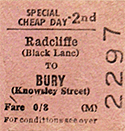 The summer timetable for 1970 showed 19 up and 17 down services on Monday-to-Saturday. The last trains ran on Saturday 3 October 1970. The last departure from Radcliffe Black Lane was the 20.10 service to Rochdale. The station closed completely on Monday 5 October 1970. The summer timetable for 1970 showed 19 up and 17 down services on Monday-to-Saturday. The last trains ran on Saturday 3 October 1970. The last departure from Radcliffe Black Lane was the 20.10 service to Rochdale. The station closed completely on Monday 5 October 1970.
Track-lifting between Bury Knowsley Street and Bolton took place in 1971.
The station buildings were demolished but the platforms survived until the early 1990s.
Tickets from Michael Stewart, signalling information from Tony Graham and route map by Alan Young
Sources:
- A Regional History of the Railways of Great Britain - Volume 10 The North West - Geoffrey O Holt, David & Charles 1986.
- Forgotten Railways - North West England - John Marshall, David & Charles 1981.
- Lost Stations of North West England - Paul Wright, Silverlink Publishing 2011.
- Railways In and Around Bury - Jeffrey Wells, Book Law Publications 2006.
- The Decline of British Railways in Bury & Rossendale - Andrew Coward, 2013.
- The Lancashire & Rorkshire Railway, Volume 1 - John Marshall, David & Charles 1969.
- The Lancashire & Yorkshire Railway Volume 2 - John Marshall, David & Charles 1970.
Click here to see the other stations between Bolton and Castleton:
Darcy Lever, Bradley Fold, Bury Knowsley Street,
Heap Bridge Goods, Broadfield, Heywood (2nd) and Heywood (1st)
See also: Ainsworth Road Halt |



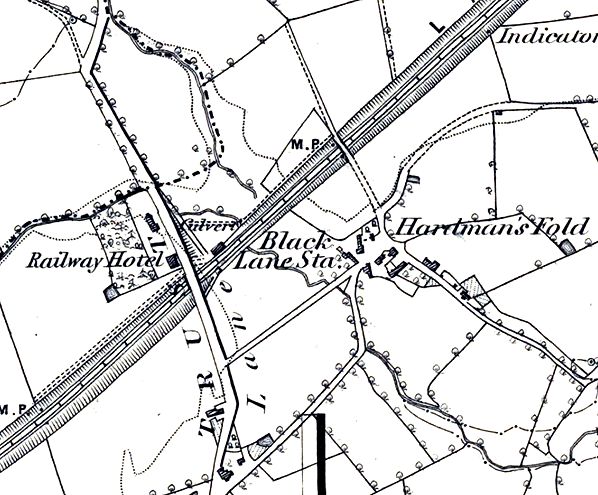
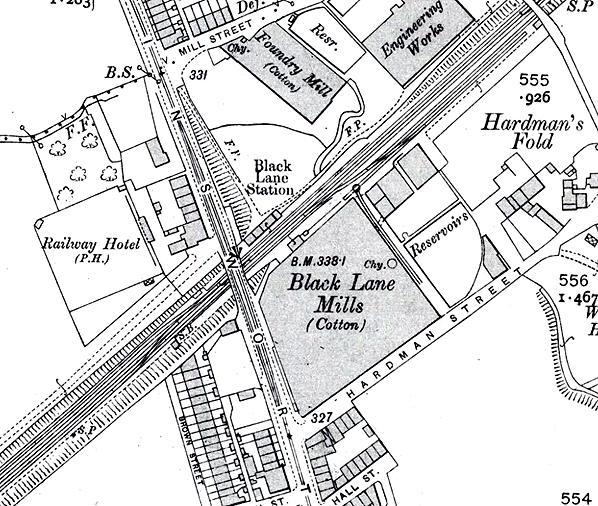
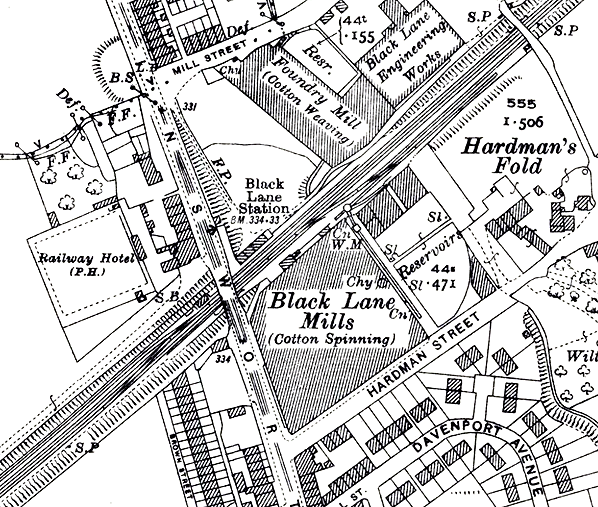
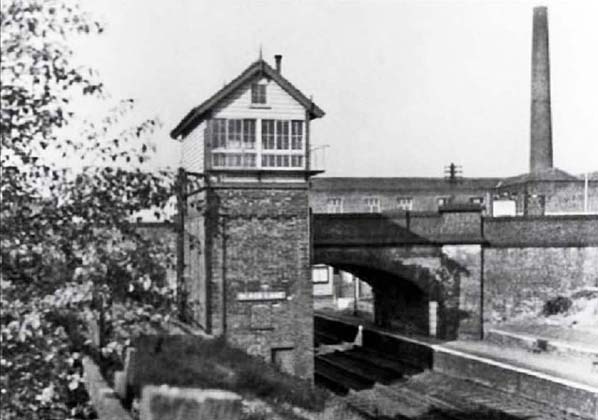
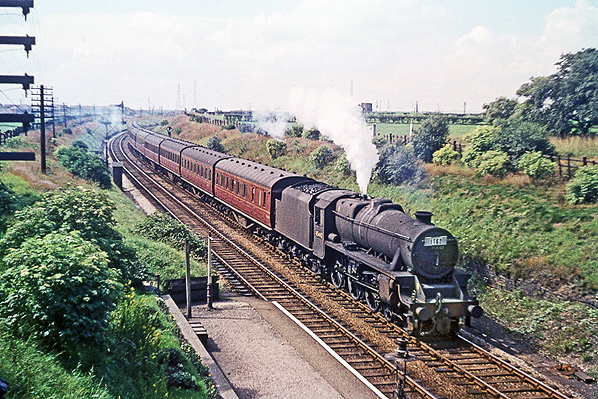
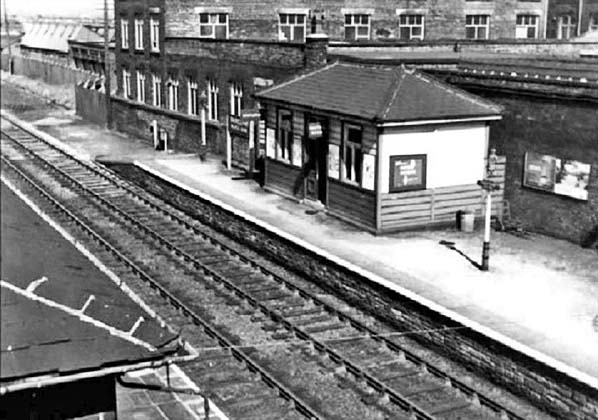
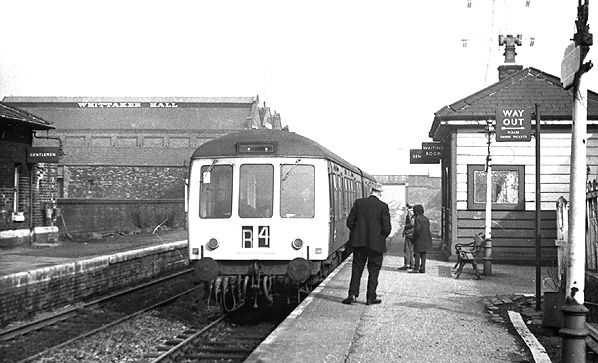
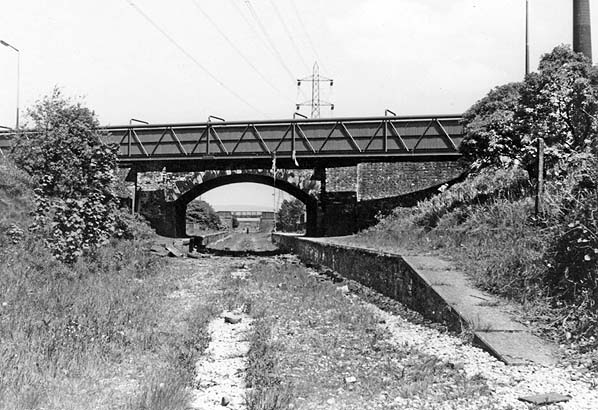
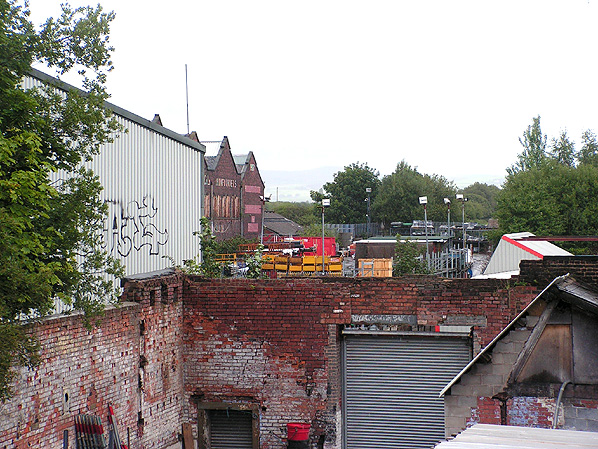

 Black Lane was not provided with public goods sidings as it was only 2 miles from Bury Knowsley Street which had extensive facilities.
Black Lane was not provided with public goods sidings as it was only 2 miles from Bury Knowsley Street which had extensive facilities. The LYR opened a halt on Ainsworth Road a short distance to the south of Black Lane station on 1 January 1918. It was on a line that had opened between Radcliffe South Junction and Bradley Fold Junction (the latter being ½ mile to the west of Black Lane station) on 1 December 1879. The halt was served by a rail-motor train that ran between Bolton and Radcliffe and it would have competed with the tramway for business.
The LYR opened a halt on Ainsworth Road a short distance to the south of Black Lane station on 1 January 1918. It was on a line that had opened between Radcliffe South Junction and Bradley Fold Junction (the latter being ½ mile to the west of Black Lane station) on 1 December 1879. The halt was served by a rail-motor train that ran between Bolton and Radcliffe and it would have competed with the tramway for business.  The LMS timetable for the summer of 1947 showed 15 trains in each direction on Monday-to-Friday. On Saturday there were 17 up and 19 down services. The station was open on Sundays being served by seven trains in each direction. On 1 January 1948 Radcliffe Black Lane became part of British Railways (BR) London Midland Region (LMR). The BR(LMR) timetable for summer 1949 showed a similar level of service to that of the LMS during its last year.
The LMS timetable for the summer of 1947 showed 15 trains in each direction on Monday-to-Friday. On Saturday there were 17 up and 19 down services. The station was open on Sundays being served by seven trains in each direction. On 1 January 1948 Radcliffe Black Lane became part of British Railways (BR) London Midland Region (LMR). The BR(LMR) timetable for summer 1949 showed a similar level of service to that of the LMS during its last year. 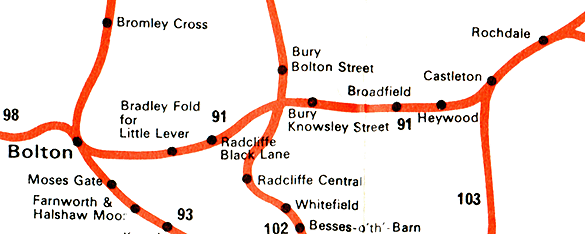
 The summer timetable for 1970 showed 19 up and 17 down services on Monday-to-Saturday. The last trains ran on Saturday 3 October 1970. The last departure from Radcliffe Black Lane was the 20.10 service to Rochdale. The station closed completely on Monday 5 October 1970.
The summer timetable for 1970 showed 19 up and 17 down services on Monday-to-Saturday. The last trains ran on Saturday 3 October 1970. The last departure from Radcliffe Black Lane was the 20.10 service to Rochdale. The station closed completely on Monday 5 October 1970.
 Home Page
Home Page